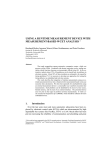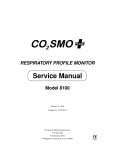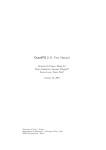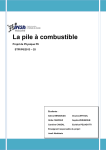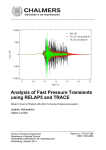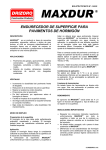Download User's Manual of the Library MSARGIBB Version 0.1
Transcript
User’s Manual of the Library MSARGIBB
Version 0.1
Matteo Pelagatti
1
Introduction
This library consists of a number of procedures, which allow a quick and
modular writing of the code related to the bayesian analysis of dynamic
models. Although the routines are not too optimized from a programming
point of view, they have proved to be reasonably fast and robust.
The choice of splitting the problems into smaller problems has permitted
an easier debugging and testing of the code and a great flexibility in model
building.
Once the ascii file msargibb.src has been placed in the src directory of
Gauss, the library msargibb can be created using the syntax lib msargibb
msargibb.src. The library can than be loaded into a Gauss session or
program just with the instruction library msargibb, letting all the included
procedures be visible to Gauss.
In the next sections, the use of every procedure in the library will be
explained. All the procedures use only local variables, and no global variables
are neither created, nor modified by the routines. The order in which the
procedures are presented is alphabetical.
The library may contain bugs, so use it at your own risk.
2
COV AR
• Purpose
Calculates the p × p autocorrelation matrix of a stationary AR(p) process with unit innovation’s variance, given the p autoregressive parameters.
• Format
Sigma = COV AR(phi)
1
• Input
phi
• Output
Sigma
3
p-dimensional (column or row) vector of autoregressive
parameters.
p × p autocorrelation matrix of the AR(p) process.
ERGODIC
• Purpose
Calculates the vector of ergodic (or stationary) probabilities of an ergodic Markov chain with finite state space, given the transition (or
stochastic) matrix.
• Format
v = ERGODIC(P)
• Input
P
• Output
v
4
Transition matrix (either the columns or the rows must
sum to one).
vector of ergodic probabilities.
ETALIZER
• Purpose
Calculates the value of the likelihood functions of an autoregressive
mean-switching model for every possible state.
• Format
L = ETALIZER(y,mu,sigma,phi,S)
• Input
2
y
mu
sigma2
phi
S
• Output
L
5
(n × 1) vector containing the n observations.
(2 × 1) vector containing the means of the switching process: mu[0] being the mean of the first state, and mu[0]
+ mu[1] being the mean of the second state.
(n × 1) vector (in case of etheroskedasticity) of variances
or scalar variance value (in case of omoschedasticity) of
the model’s innovations.
(p × 1) vector of autoregressive parameters.
(k × p + 1) binary (0-1) matrix of states and lagged states:
column 1 contains the k states at time t, column 2 contains the k states at time t − 1,..., column p + 1 contains
the k states at time t − p.
(k × n − p) matrix containing the the likelihood values
for every period (column index = p + 1, . . . , n) and every
state (row index = 1, . . . , k). The first p columns are lost.
HAM FLT
• Purpose
Calculates Hamilton’s filter: the filtered probabilities of being in each
of the m states of a Markov switching model at every time t = 1, . . . , n.
• Format
xiflt = HAM FLT(xi0,P,eta)
• Input
xi0
P
eta
• Output
xiflt
(m × 1) vector containing the initial (i.e. time t = 0)
probabilities of the m states.
(m × m) transition matrix of the Markov chain. Important: the matrix must be stochastic in the columns, that
it, the elements of every column must sum to one.
(m × n) matrix containing the the likelihood values for
every period (column index = 1, . . . , n) and every state
(row index = 1, . . . , m)
(m × n) matrix containing the filtered probabilities of
being in state i, i = 1, . . . m row index, at time t,
t = 1, . . . , n column index.
3
6
KIM SMO
• Purpose
Calculates Kim’s smoother: the smoothed probabilities of being in each
of the m states of a Markov switching model at every time t = 1, . . . , n.
• Format
xismo = kim smo(xiflt,P)
• Input
xiflt
P
• Output
xismo
7
(m × n) matrix containing the filtered probabilities of
being in state i (i = 1, . . . m row index) at time t
(t = 1, . . . , n column index). It can be computed using
the procedure HAM FLT.
(m × m) transition matrix of the Markov chain. Important: the matrix must be stochastic in the columns, that
it, the elements of every column must sum to one.
(m × n) matrix containing the smoothed probabilities of
being in state i, i = 1, . . . m row index, at time t, t =
1, . . . , n column index.
LIN SAMP
• Purpose
It generates random values from the posterior distributions of the parameters β and σ 2 of the following Bayesian Gaussian linear model
y ∼ N (Xβ, σ 2 In )
with prior distributions σ 2 ∼ IG(n0 /2, nv0 /2) and β|σ 2 ∼ N (b0 , σ 2 A0 ).
• Format
{beta,sigma2} = lin samp(y,X,b0,A0,n0,nv0)
• Input
4
y
X
b0
A0
n0
nv0
• Output
beta
sigma2
8
(n × 1) vector of observations.
(n × k) matrix of covariates.
(k × 1) vector of prior means for β.
(k × k) matrix of prior covariances when σ 2 = 1.
(1×1) two times the first parameter of the inverse gamma
distribution (it can be interpreted as the number of observations on which the prior information about σ 2 is based).
(1 × 1) two times the second parameter of the inverse
gamma distribution.
(k × 1) vector of random values from the posterior of β.
(1 × 1) random value from the posterior of σ 2 .
MSVARTA
• Purpose
Calculates the value of the likelihood functions of a vector autoregressive mean-switching model for every possible state. It is the multivariate analogous of procedure ETALIZER.
• Format
eta = msvarta(Y,mu0,mu1,Sig,A,S)
• Input
Y
mu0
mu1
Sig
A
S
• Output
eta
(k × n) matrix containing k time series with n observations.
(k × 1) vector of state 0 means.
(k × 1) vector of state 1 means’ increments: state 1 means
equal mu0 + mu1.
(k × k) covariance matrix of the model’s innovations.
(k × pk) matrix of VAR coefficient matrices: A =
[A1 , . . ., Ap ].
(m × p + 1) binary (0-1) matrix of possible states at lags
0, 1, . . . , p.
(m × n − p) matrix of likelihood values for every state
(rows) and every period (columns); the first p columns
are lost.
5
9
NEW BETA
• Purpose
Generates a new set of probit model’s coefficients β, using the data
augmentation technique and Bayesian inference.
• Format
beta1 = new beta(s,X,beta0,diffuse,m0,V0)
• Input
s
(n × 1) binary (0-1) vector of response variable observations.
X
(n × k) matrix of covariates (or design matrix).
beta0
(k × 1) vector of the last generated coefficients β.
diffuse (1 × 1) when equal to 0 a proper normal prior N (m0 , V0 )
is used, otherwise a diffuse prior is adopted.
m0
(k × 1) mean vector of the normal prior distribution for
the coefficients β (if diffuse = 0, it is not used).
V0
(k × k) covariance matrix of the normal prior distribution
for the coefficients β (if diffuse = 0, it is not used).
• Output
beta1
10
(k × 1) vector of new generated values from the posterior
distribution of β.
RNDTN
• Purpose
Auxiliary function used by new beta: it generates a series of truncated
normal random variables according to the rule
if st = 0 than zt ∼ N (µt , 1)I(−∞,0) (zt )
,
if st = 1 than zt ∼ N (µt , 1)I[0,∞) (zt )
I{.} being the indicator function.
• Format
z = rndtn(s,mu)
• Input
s
mu
(n × 1) binary (0-1) vector.
(n × 1) mean vector.
• Output
z
(n × 1) sample of truncated normal variables.
6
11
NEW MU
• Purpose
It generates values for the two means of an autoregressive Markov
switching model in the means, MSM-AR(p), from their posterior distribution, given either Gaussian or diffuse priors, and the other parameters of the model.
• Format
mu = new mu(y,phi,s,sigma,diffuse,m0,V0)
• Input
y
phi
s
(n × 1) observations’ vector.
(p × 1) parameters of the AR(p) model.
(n × 1) binary (0-1) state vector: when st = 0 the process
has mean µ0 , when st = 1 the process has mean µ0 + µ1 .
sigma
(n×1) standard deviation of the innovations of the process
(it can be a scalar).
diffuse (1 × 1) when equal to 0 a proper normal prior N (m0 , V0 )
for the means is used, otherwise a diffuse prior is adopted.
m0
(2 × 1) mean vector of the normal prior distribution for
the means µ (if diffuse = 0, it is not used).
V0
(2 × k) covariance matrix of the normal prior distribution
for the means µ (if diffuse = 0, it is not used).
• Output
mu
12
(n × 1) sample from the posterior of the means of the
MSM-AR process.
NEW PHI
• Purpose
It generates values for the autoregressive parameters of an autoregressive Markov switching model in the means, MSM-AR(p), from their
posterior, given either Gaussian or diffuse priors, and the other parameters of the model.
• Format
phi = new phi(y,mu,s,sigma,p,diffuse,m0,V0)
• Input
7
(n × 1) observations’ vector.
(2 × 1) means of the MSM-AR(p) model.
(n × 1) binary (0-1) state vector: when st = 0 the process
has mean µ0 , when st = 1 the process has mean µ0 + µ1 .
sigma
(n×1) standard deviation of the innovations of the process
(it can be a scalar).
diffuse (1 × 1) when equal to 0 a proper normal prior N (m0 , V0 )
for the autoregressive coefficients is used, otherwise a diffuse prior is adopted.
m0
(p × 1) mean vector of the normal prior distribution for
the autoregressive coefficients φ (if diffuse = 0, it is not
used).
V0
(p × p) covariance matrix of the normal prior distribution
for the autoregressive coefficients φ (if diffuse = 0, it is
not used).
y
mu
s
• Output
phi
13
(n × 1) sample from the posterior of the autoregressive
coefficients of the MSM-AR process.
NEW SIGMA2
• Purpose
It generates a random value from the posterior of the innovations’ variance of an autoregressive Markov switching model in the means, MSMAR(p), given either an inverse gamma or diffuse prior, and the other
parameters of the model.
• Format
sig2 = new sigma2(y,mu,phi,s,diffuse,alpha,beta)
• Input
8
(n × 1) observations’ vector.
(2 × 1) means of the MSM-AR(p) model.
(p × 1) vector of the p autoregressive parameters.
(n × 1) binary (0-1) state vector: when st = 0 the process
has mean µ0 , when st = 1 the process has mean µ0 + µ1 .
diffuse (1 × 1) when equal to 0 a proper inverse gamma prior
N (m0 , V0 ) for the innovations’ variance is used, otherwise
a diffuse prior is adopted.
alpha
(1 × 1) first parameter of the inverse gamma distribution
(if diffuse = 0, it is not used).
beta
(1 × p) second parameter of the inverse gamma distribution (if diffuse = 0, it is not used).
y
mu
phi
s
• Output
sig2
14
(1 × 1) sample from the posterior of the innovations’ variance of the MSM-AR process.
NY
• Purpose
It graphs a line plot of one or more series.
• Format
ny(y)
• Input
y
(n × k) matrix containing k series of length n.
• Output
no output.
15
PROBIT
• Purpose
It calculates the varying probability of transition of a two states Markov
chain, using the following probit duration dependence model
probit(St ) = β1 + β2 St−1 + β3 Dt−1 St−1 + β4 Dt−1 (1 − St−1 )
with St binary (0-1) state variable, and Dt duration variable, that
counts the number of consecutive periods since last change of state,
in which the system has been in the same state, at time t.
9
• Format
prob = probit(par,maxdur)
• Input
par
maxdur
• Output
prob
16
(4 × 1) vector of the β-parameters of the model.
(1 × 1) number of periods, after which the durations no
more influence the probability of transition.
(maxdur×4) matrix of the following probabilities of transition after d times: p00 (d), p01 (d), p10 (d), p11 (d).
PROBIT2
• Purpose
It calculates the varying probability of transition of a two states Markov
chain, using the following probit duration dependence model
probit(St ) = β1 St−1 + β2 Dt−1 St−1 + β3 (1 − St−1 ) + β4 Dt−1 (1 − St−1 )
with St binary (0-1) state variable, and Dt duration variable, that
counts the number of consecutive periods since last change of state,
in which the system has been in the same state, at time t.
• Format
prob = probit2(par,maxdur)
• Input
par
maxdur
• Output
prob
17
(4 × 1) vector of the β-parameters of the model.
(1 × 1) number of periods, after which the durations no
more influence the probability of transition.
(maxdur×4) matrix of the following probabilities of transition after d times: p00 (d), p01 (d), p10 (d), p11 (d).
RNDDIS
• Purpose
It generates n discrete random quantities with support {1, 2, . . . , m}
and a given probability distribution.
• Format
x = rnddis(n,p)
10
• Input
n
p
• Output
x
18
(1 × 1) number of random quantities to be generated.
(m × 1) vector containing the ordered probabilities for
each event {1, 2, . . . , m}. The sum of the m values must
be one.
(n × 1) vector of n sample points of the discrete random
quantities.
RNDIGAM
• Purpose
It generates a matrix of i.i.d. random quantities from an Inverse-Gamma
distribution
β α e−β/x
f (x|α, β) =
I[0,∞) (x),
Γ(α) xα+1
which is the distribution of the reciprocal of a Gamma random variable
with parameters α and β.
• Format
x = rndigam(r,c,alpha,beta)
• Input
r
c
alpha
beta
(1 × 1)
(1 × 1)
(1 × 1)
(1 × 1)
• Output
x
(r × c) matrix of i.i.d. Inverse-Gamma random numbers.
19
number of rows of the output matrix.
number of columns of the output matrix.
α-parameter of the Inverse-Gamma distribution.
β-parameter of the Inverse-Gamma distribution.
RNDMTN
• Purpose
It draws a (p × q) random matrix from a matrix-normal distribution with mean-matrix M rows-covariance matrix V and columnscovariance matrix K.
• Format
X = rndmtn(M,V,K)
11
• Input
M
V
K
(p × q) matrix of means.
(p × p) rows-covariance matrix.
(q × q) columns-covariance matrix.
• Output
X
(p × q) matrix of random matrix-normal numbers.
20
RNDMVN
• Purpose
It draws a random vector from a multivariate normal distribution with
mean vector µ and covariance matrix Σ.
• Format
x = rndmvn(mu,Sigma)
• Input
mu
Sigma
(m × 1) mean vector.
(m × m) covariance matrix.
• Output
x
(m × 1) vector of multivariate normal numbers.
21
RNDW
• Purpose
It draws a random (m × m) matrix from a Whishart distribution with
parameters H and n ∈ N.
• Format
X = rndw(H,n)
• Input
H
n
(m × m) parameter’s matrix.
(1 × 1) number of degrees of freedom.
• Output
X
(m × m) matrix drawn from a Whishart distribution.
12
22
RND MU
• Purpose
It generates a vector of random quantities from the posterior distribution of the stacked means of the Markov-switching-in-mean VAR
(MSM-VAR(p)) model
yt = µ0 +µ1 st +A1 (yt−1 −µ0 −µ1 st−1 )+. . .+Ap (yt−p −µ0 −µ1 st−p )+εt ,
given the other parameters and a normal prior distribution.
• Format
mu = rnd mu(Y,s,p,A,Sig,m0,invM0)
• Input
Y
s
p
A
Sig
m0
invM0
• Output
mu
23
(k × n) matrix containing in the rows the k observed time
series.
(n × 1) or (1 × n) binary (0-1) vector of states.
(1 × 1) number of lags of vector autoregression.
(k × kp) matrix of all the autoregressive parameters: A =
(A1 , . . . , Ap ).
(k × k) covariance matrix of vector innovations εt .
(2k × 1) prior mean vector for (µ00 , µ01 )0 .
(2k × 2k) inverse of the prior covariance matrix for
(µ00 , µ01 )0 .
(2k × 1) random number drawn from the posterior distribution of (µ00 , µ01 )0 .
RND REG
• Purpose
It draws a random matrix from the posterior distribution of the parameter matrix B of the following multivariate regression model:
Y = BX + E,
where Y is a matrix of k variates with n observations, X is a matrix of
m covariates with n observations, B is a (k × m) matrix of regression
parameters and E is a matrix whose n columns are random vectors with
zero expectation and covariance matrix Σ. The prior for the regression
parameters is matrix normal, while the prior for Σ is diffuse.
13
• Format
{beta,Sigma} = rnd reg(Y,X,b0,invBB0)
• Input
Y
X
b0
invBB0
• Output
beta
Sigma
24
(k × n) observation matrix with the n observations of the
k variates.
(m × n) observation matrix with the n observations of the
m covariates.
(km × 1) vector of prior means for vec(B).
(km × km) inverse of the prior covariance matrix for
vec(B).
(km × 1) random draw from the posterior of vec(B).
(k × k) random draw from the posterior of vec(Σ).
RND REGS
• Purpose
Same as the rnd regs procedure, but with Σ given.
• Format
beta = rnd regs(Y,X,b0,invBB0,Sigma)
• Input
Y
X
b0
invBB0
• Output
beta
25
(k × n) observation matrix with the n observations of the
k variates.
(m × n) observation matrix with the n observations of the
m covariates.
(km × 1) vector of prior means for vec(B).
(km × km) inverse of the prior covariance matrix for
vec(B).
(km × 1) random draw from the posterior of vec(B).
ST SAMPL
• Purpose
In a Markov switching framework, it generate a state vector (discrete
number in {1, 2, . . . , r}), given the transition matrix P and the matrix
of Hamilton-filtered probabilities.
14
• Format
s = st sampl(xi,P)
• Input
xi
P
• Output
s
26
(m × n) matrix of Hamilton-filtered probabilities for m
states and n observations.
(m × m) transition matrix (columns sum to one) of the
m states Markov chains.
(n × 1) vector of sampled states.
KALMANF
• Purpose
It runs the Kalman filter on the dynamic linear model
yt = Zt αt + dt + εt
αt = Tt αt−1 + ct + Rt η t ,
with E(α0 ) = a0 and Var(α0 ) = P0 .
• Format
{a,P,aa,PP,fe,F} = kalmanf(y,Z,d,H,T,c,R,Q,a0,P0)
• Input
y
Z
d
H
T
c
R
Q
a0
P0
(k × n) matrix of k time series with n observation.
(k × mn) matrix of n regression (k × m) matrices (one for
each t ∈ {1, . . . , n}).
(k × n) matrix of n (k × 1) vectors of constant terms (one
for each t ∈ {1, . . . , n}).
(k × kn) matrix of n covariance (k × k) matrices of the
observational disturbances (one for each t ∈ {1, . . . , n}).
(m × mn) matrix of n transition (m × m) matrices (one
for each t ∈ {1, . . . , n}).
(m × n) matrix of n (k × 1) vectors of constant terms (one
for each t ∈ {1, . . . , n}).
(m × gn) matrix of n (m × g) transformation matrices for
the random vector η t (one for each t ∈ {1, . . . , n}).
(g × gn) matrix of n g × g covariance matrices of the
transition disturbance (one for each t ∈ {1, . . . , n}).
(m × 1) expectation vector for the state α0 .
(m × m) covariance matrix for the state α0 .
15
• Output
a
P
aa
PP
fe
F
27
(m × n) expectation vectors of the filtered states.
(m × mn) covariance matrices of the filtered states.
(m × n) expectation vectors of the (1-step-ahead) predicted states.
(m × mn) covariance matrices of the (1-step-ahead) predicted states.
(m × n) (1-step-ahead) prediction error.
(m × mn) covariance matrices of the (1-step-ahead) prediction error.
SSAMPLER
• Purpose
It generates an n-variate random draw from the joint smoothing distribution of the normal dynamic linear model
yt = Zt αt + dt + εt
αt = Tt αt−1 + ct + Rt η t ,
with εt ∼ N (0, Ht ), η t ∼ N (0, Rt Qt R0t ) and α0 ∼ N (a0 , P0 ).
• Format
alpha = ssampler(a,P,T,Q,c,R)
• Input
a
P
T
Q
c
R
• Output
alpha
(m × n) matrix of n expectation vectors (one for each
t ∈ {1, . . . , n}) of the (Kalman) filtered states.
(m × mn) matrix of n covariance matrices (one for each
t ∈ {1, . . . , n}) of the (Kalman) filtered states.
(m × mn) matrix of n transition (m × m) matrices (one
for each t ∈ {1, . . . , n}).
(g × gn) matrix of n g × g covariance matrices of the
transition disturbance (one for each t ∈ {1, . . . , n}).
(m × n) matrix of n (k × 1) vectors of constant terms (one
for each t ∈ {1, . . . , n}).
(m × gn) matrix of n (m × g) transformation matrices for
the random vector η t (one for each t ∈ {1, . . . , n}).
(m × n) random draws from the joint smoothing distribution of the normal dynamic linear model.
16
28
SV HSAMP
• Purpose
It generates a random vector from the (approximated) conditional joint
smoothing distribution of the variances ht of the following stochastic
volatility model
log zt2 = ht + log ε2t
ht = ν + φht−1 + ηt ,
with ε ∼ N (0, 1) and η ∼ N (0, σ 2 ). The procedure is thought to be
used in a Gibbs sampler, and therefore previously generated values of
ν, φ, σ 2 and {ht }Tt=1 must be provided.
• Format
h = sv hsamp(y,h,nu,phi,sigma2,m0,V0)
• Input
y
h
nu
phi
sigma2
m0
V0
• Output
h
29
(n × 1) log squared observations: y = log z 2 .
(n × 1) vector of previously sampled state variables.
(1 × 1) constant of the AR(1) model for ht .
(1 × 1) autoregressive parameter of the AR(1) model for
ht .
(1 × 1) variance of the innovations of the AR(1) model for
ht .
(1 × 1) mean of the initial state h0 .
(1 × 1) variance of the initial state h0 .
(n × 1) vector of sampled state variables from the joint
smoothing distribution of ht , t = 1, . . . , n.
SV LL
• Purpose
It calculates the value of the (quasi) log-likelihood of the following
stochastic volatility model:
log zt2 = ht + log ε2t
ht = ν + φht−1 + ηt ,
with ε ∼ N (0, 1) and η ∼ N (0, σ 2 ).
17
• Format
ll = sv ll(nps,y)
• Input
nps
y
• Output
ll
(3 × 1) vector containing the three parameters of the
stochastic volatility model, respectively, ν, φ and σ.
(n × 1) log squared observations: y = log z 2 .
(1 × 1) value of the (quasi) log-likelihood.
18



















